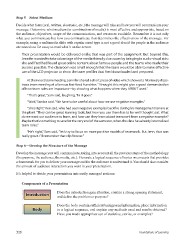Page 332 - Foundations of Learning, 4th Edition (Revised)
P. 332
Step 5—Select Medium
Decide what form (oral, written, electronic, etc.) the message will take and how you will communicate your
message. Determine what medium (or combination of media) is most effective and appropriate, based on
the audience, objectives, scope of the communication, and resources available. Remember it is not only
what you communicate but how you communicate that determines the effectiveness of the message. For
example, using a multimedia slide with regular sized type is not a good idea if the people in the audience
are seated too far away to read what’s on the screen.
Their presentation would be delivered orally; that was part of the assignment. But beyond this,
Jennifer wanted to take advantage of the media-friendly classroom by bringing in audio-visual aids:
she and Fred had found great online content about famous people and the teams who made their
success possible. The classroom was small enough that the team would be able to make effective
use of the LCD projector to show the team profiles that Fred downloaded and prepared.
At their next team meeting, Jennifer shared a short piece of video which showed a hilariously disas-
trous team meeting at a famous fast-food franchise. “I thought this might give a good demonstration
of how team roles are important—by showing what happens when they AREN’T used.”
“That’s great,” Sam said, laughing. “In it goes.”
“Wait,” Sandra said. “We have to be careful about how we use negative examples.”
“She’s right,” Ken said, who had seen negative examples backfire during his management tenure at
the plant. “They can be great learning tools, but how you use them has to be well thought out. What
do we want our audience to learn, and how can they learn about teamwork from a negative example?
Maybe that’s something to save for the very end of the semester, when the class has already internalized
team roles.”
“He’s right,” Sam said, “let’s try to focus on more positive models of teamwork. But Jenn, that was
really great. I’ll remember that clip forever.”
Step 6—Develop the Structure of the Message
Develop the message you will communicate, taking into account all the previous steps of the methodology
(the purpose, the audience, the media, etc.). Generate a logical sequence of topics or concepts that provides
a framework for you to deliver your message and for the audience to understand it. You should also consider
the amount of audience interaction you want in your presentation.
It’s helpful to divide your presentation into easily managed sections:
Components of a Presentation
Does the introduction gain attention, contain a strong opening statement,
and define the problem or purpose?
Does the body contain sufficient background information, place information
in a logical sequence, and explain any methods used and results obtained?
Have you made appropriate use of statistics, stories, or examples?
326 Foundations of Learning

